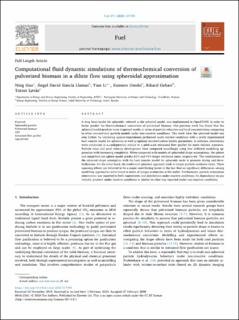| dc.contributor.author | Guo, Ning | |
| dc.contributor.author | García Llamas, Ángel David | |
| dc.contributor.author | Li, Tian | |
| dc.contributor.author | Umeki, Kentaro | |
| dc.contributor.author | Gebart, Rikard | |
| dc.contributor.author | Løvås, Terese | |
| dc.date.accessioned | 2020-04-02T07:15:30Z | |
| dc.date.available | 2020-04-02T07:15:30Z | |
| dc.date.created | 2020-04-01T10:45:26Z | |
| dc.date.issued | 2020 | |
| dc.identifier.citation | Fuel. 2020, 271 | en_US |
| dc.identifier.issn | 0016-2361 | |
| dc.identifier.uri | https://hdl.handle.net/11250/2649993 | |
| dc.description.abstract | A drag force model for spheroids, referred as the spheroid model, was implemented in OpenFOAM, in order to better predict the thermochemical conversion of pulverized biomass. Our previous work has found that the spheroid model predicts more dispersed results in terms of particle velocities and local concentrations comparing to other conventional particle models under non-reactive conditions. This work takes the spheroid model one step further, by validating against experiments performed under reactive conditions with a newly implemented heat transfer model for spheroids as well as updated devolatilization kinetic parameters. In addition, simulations were conducted in a configuration similar to a pilot-scale entrained flow gasifier for more realistic scenarios. Particle mass and axial velocity development were compared accordingly using four different modelling approaches with increasing complexity. When compared with models of spheroidal shape assumptions, the sphere and simplified non-sphere model predict 61 % and 43 % longer residence times, respectively. The combination of the spheroid shape assumption with the heat transfer model for spheroids tends to promote drying and devolatilization. On the other hand, the traditional spherical approach leads to longer particle residence times. These opposing effects are believed to be a major contributing factor to the fact that no significant differences among modelling approaches were found in terms of syngas production at the outlet. Furthermore, particle orientation information was reported in both experiments and simulations under reactive conditions. Its dependency on gas velocity gradient under reactive conditions is similar to what was reported under non-reactive conditions. | en_US |
| dc.language.iso | eng | en_US |
| dc.publisher | Elsevier | en_US |
| dc.relation.uri | https://www.sciencedirect.com/science/article/pii/S0016236120304907 | |
| dc.rights | Navngivelse 4.0 Internasjonal | * |
| dc.rights.uri | http://creativecommons.org/licenses/by/4.0/deed.no | * |
| dc.title | Computational fluid dynamic simulations of thermochemical conversion of pulverized biomass in a dilute flow using spheroidal approximation | en_US |
| dc.type | Peer reviewed | en_US |
| dc.type | Journal article | en_US |
| dc.description.version | publishedVersion | en_US |
| dc.source.volume | 271 | en_US |
| dc.source.journal | Fuel | en_US |
| dc.identifier.doi | 10.1016/j.fuel.2020.117495 | |
| dc.identifier.cristin | 1804733 | |
| dc.relation.project | Norges forskningsråd: 244069 | en_US |
| dc.description.localcode | This is an open access article distributed under the terms of the Creative Commons CC-BY license, which permits unrestricted use, distribution, and reproduction in any medium, provided the original work is properly cited. | en_US |
| cristin.ispublished | true | |
| cristin.fulltext | original | |
| cristin.qualitycode | 2 | |

